| Stone Mauls |
| Our ancestors in the Pacific Northwest were some of the finest toolmakers in North America. The tools they made were fashioned from materials such as stone, bone, antlers and shells. These tools were very versatile and were used to build all types of different structures including totem poles, ocean-going canoes and houses. Along with their functional uses, the tools were works of art that served as a testament to our ancestors’ traditions, cultural and spiritual values. One of the more versatile tools of the Pacific Northwest was the stone maul. It was used for pounding and hammering during activities such as woodworking and food preparation. |
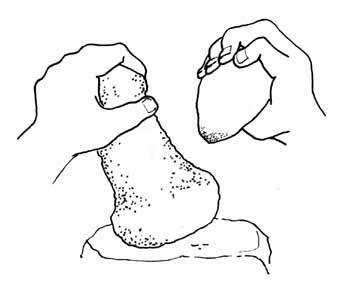 Pecking Method Source Illustration: Artifacts of the Northwest Coast Indians |
Mauls are very difficult to make. Because they suffer such wear and tear, they must be made from very hard stone. The hardness of the stone presents a problem: the tool used to fashion it into a useful shape must be as hard as the maul stone itself or even harder. The toolmaker of the Pacific Northwest made mauls by using a pecking and grinding technique, which required patience and persistence. The shape of the stone determined the type of maul that was manufactured. Breaking off bits of stone with a stone pebble, the toolmakers refined the stone’s natural shape into that of an identifiable maul. To by-pass some of the tedious work of constant pecking, the toolmakers sometimes etched out rough columns by pecking vertical grooves into the stone. The columns could then be struck off the stone in large chunks saving time and effort. |
|
|
||
When the rough shape was finished, the maul moved to the next phase of manufacturing, grinding. The toolmaker used an abrader made from a gritty stone such as a slab of sandstone. Just like modern sand paper, abraders came in different grades: course, medium, fine and even super fine. The abraders allowed the toolmaker to grind smooth the maul surface. Once the surface abrading was complete, a piece of oiled hide was used to polish the tool so that it was comfortable to hold and beautiful to look at.
|
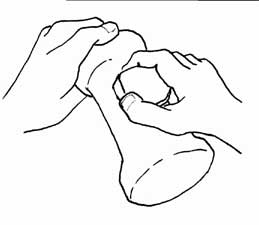 Grinding Method Source Illustration: Artifacts of the Northwest Coast Indians |
|
|
Our west coast ancestors manufactured many types and shapes of mauls. They can be classified into the following four groups: hand mauls, grooved and perforated mauls, cylindrical mauls and stirrup mauls. |
| A hand maul was a heavy-duty hand-held hammer which had to be used by someone with strong arms. It was used for a number of purposes, and played a very specific role in the construction of houses and canoes on the Northwest Coast. The hand mauls was used to drive wedges into cedar logs to split off large planks of wood. This is the same function served by circular saws in modern lumber yards. Hand mauls were also used into the kitchen. Women used these mauls in food preparation to mash up plants such as salal and elderberries. These plants were ground and made into flat cakes for preservation. Over time through frequent use, the tool would become pitted or concave. Eventually, like all other tools, it would break and need to be replaced. |
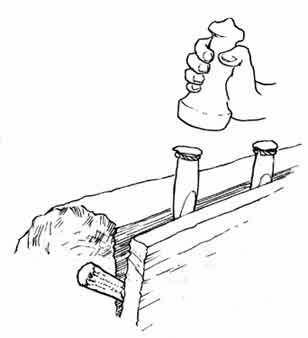 Splitting Wood Planks Using a Hand Maul Source Illustration: Artifacts of the Northwest Coast Indians |
|
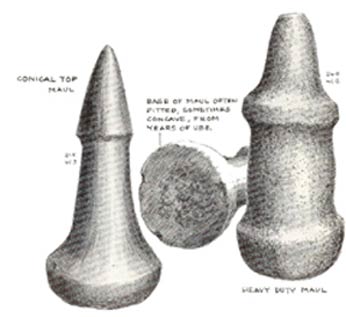 |
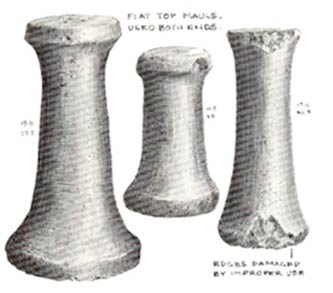 |
|
Source Illustration: Artifacts of the Northwest Coast Indians |
|
Grooved and perforated mauls were essentially hammerheads. Some heads had grooves and perforations, which depicted animal designs. The grooves were manufactured with the same technique used to shape and smooth hand held mauls. While the grooves looked decorative, their primary purpose was to provide secure lashing points with which to attach the maul head to a wooden handle. |
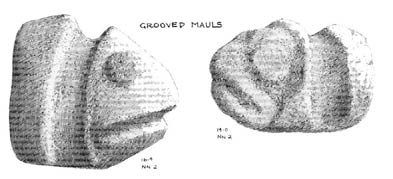 Grooved Mauls Source Illustration: Artifacts of the Northwest Coast Indians |
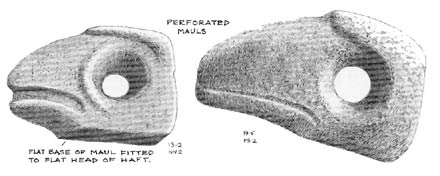 Perforated Mauls Source Illustration: Artifacts of the Northwest Coast Indians |
|
| The head was lashed to a long, stong wood handle with cord made from animal hide or sinew or plant material such as roots. The handles were fashoined from tree branches cut from the trunk; a method which provided a natural seat for the maul head. On decorated mauls the pounding end was plain and flat. Some mauls were not decorated at all: only the pounding end was worked ftat by the toolmaker while the other end was left in its natural state. These types of mauls are known as plain grooved mauls. |
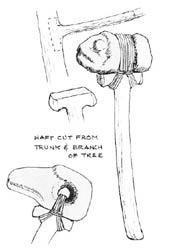 Maul Handle Source Illustration: Artifacts of the Northwest Coast Indians |
|
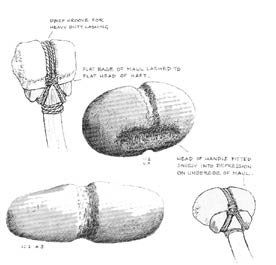 Plain Grooved Mauls Source Illustration: Artifacts of the Northwest Coast Indians |
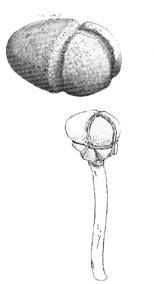 Plain Maul Hand and Lashings Source Illustration: Artifacts of the Northwest Coast Indians |
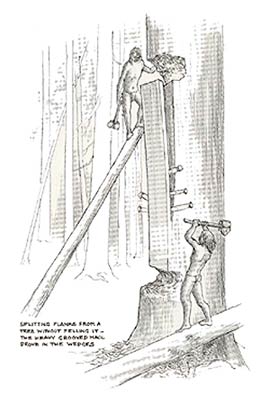 Splitting Planks from unfelled cedar tree Source Illustration: Artifacts of the Northwest Coast Indians |
|
Grooved and perforated mauls varied in size, from quite small to fairly large. The larger, heavy-duty mauls could be swung much like a sledgehammer. The Tlingit, Haida and Tsimian peoples used them to split wood planks directly off large cedar trees without cutting down the tree. |
|
 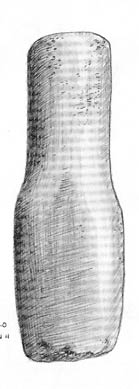 Cylindrical Maul Types Source Illustration: Artifacts of the Northwest Coast Indians |
Cylindrical mauls, as the name implies, were stone cylinders used as hand held mauls. They were probably used like a pestle to pound and grind plant materials being used for food and medicine. The stone was pecked into shape and then grounded smooth with an abrader. Some cylindrical mauls were more oval shaped, so that they fit more comfortably in the user’s hand. These days we refer to the adaptation of tools to fit and work better with the human body as ergonomics. |
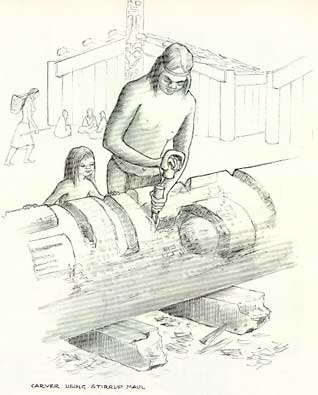 Carver Using a D-Type Maul Source Illustration: Artifacts of the Northwest Coast Indians |
|
| Stirrup mauls have (so far) only been found in the northern part of the West Coast. There are two shape variations of the stirrup maul; the D-type and the T-type. The mauls were both made using the pecking and grinding technique as other mauls, but given their unique shapes, it probably took longer to make. |
|
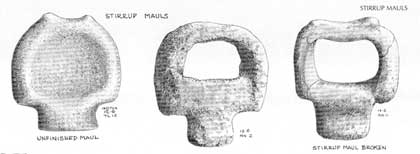 D-Type Maul Construction Source Illustration: Artifacts of the Northwest Coast Indians |
|
| The D-type maul had more stone at the top of the tool. This extra material was probably used to give the tool more weight when striking an object such as a chisel. The T-type maul incorporated flanges that may have been used as a striking head. Some T-type mauls had a sloped grip used for lateral pounding This type of maul was probably a specialized tool used to provide the proper pounding angle. It was probably used to carve odd angles in totem poles or for splitting planks off standing trees. |
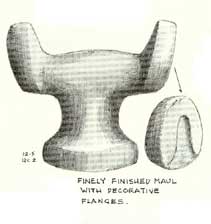 Carver Using a D-Type Maul Source Illustration: Artifacts of the Northwest Coast Indians |
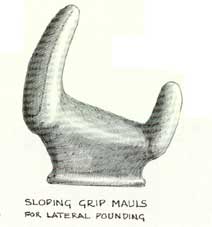 Carver Using a D-Type Maul Source Illustration: Artifacts of the Northwest Coast Indians |
For arcticle references, click here! |
|
 |